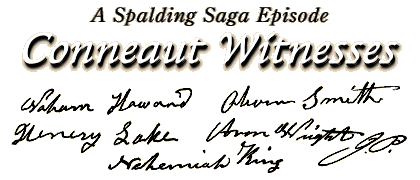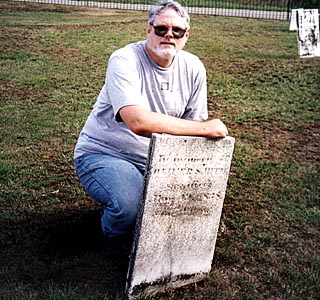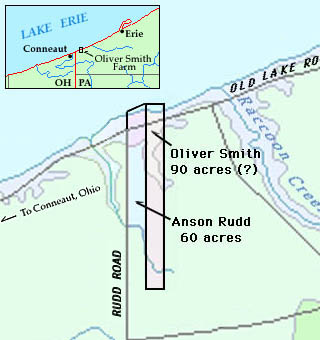- THE SPALDING RESEARCH PROJECT -
Back to Conneaut Witnesses Index Page


Oliver Smith (1767-1838)
See also: Oliver Smith's obituary
|
The Story of Oliver Smith MR Oliver Smith, Jr. (1761-1838) was one of the eight "Conneaut witnesses" whose statements are featured in E. D. Howe's 1834 book, Mormonism Unvailed. In 1891 Anna, one of his daughters, said: "Father, Oliver Smith, came to Springfield, Pa., 1798. [I] well remember S. Spaulding, who frequently came to our house and remained several days. There was but few settlers, and the latch string always hung out..." Anna is mistaken as to the date of Oliver's permanent relocation to Pennsylvania, even though he may well have visited the Springfield area as early as 1798. Oliver Smith is shown as living in Springfield twp., Erie Co., Pennsylvania in the 1810, 1820, and 1830 Federal Census returns, but not in the Springfield listing for 1800. His obituary and most published histories have him arriving in 1801; others acounts place the arrival in 1802. Oliver Smith, Jr. was born Apr. 24, 1761, in Mansfield twp, Tolland Co., Connecticut, the only known son of Oliver Smith, Sr. and Rachael Hodges. He served in the Continental Army as a youth, was discharged, and evidently married his first wife in New England in about 1785 -- her name is unknown. Oliver married Betsy Lathrop (1765-1861) in about 1798, probably in Dalton, Berkshire Co., Massachusetts, the place they were living in before they moved to Ohio, accompanied by their son Lyman (1798-1875) and Oliver's son from his previous marriage, Chester (c.1796-aft. 1803). Oliver and Betsy had nine children, beginning with Lyman on Jan. 22, 1798. He was followed by Electa in 1799; Charles Francis on Mar. 28, 1803; Oliver III on Aug. 2, 1805; Clarissa, c. 1807; Miriam, c. 1808 Freeman, b. 1810; John, c. 1812; and Amos, who was born in about 1815.  Oliver Smith's grave in East Springfield, Erie Co., PA. Oliver Smith and his family relocated from Massachusetts to Springfield twp., Erie Co., Pennsylvania in 1801-02, at about the same time as Robert McKee and other early settlers were arriving there. Not many years after the Smith's arrival they evidently moved upon a piece of property on the lake shore owned by John Rudd, Sr. of Otsego Co. New York. This land, a tract of about 350 acres, John Rudd, Sr. had obtained in 1805 from Solomon Spalding of Richfield, Otsego Co., New York. Although Mr. Rudd did not move west until 1806, his son, John Rudd, Jr. came to Springfield twp. in 1803 and erected the region's first distillery. It is believed that he cleared a portion of his father's property and divided it into several "long lots" fronting on the Lake Erie shore. The easternmost of these lots, a tract of about 90 acres, the Rudds conveyed to Oliver Smith in 1805 or 1806. Probably Oliver and his family were already living on the lot before they obtained their title from the Rudds. This 90 acres, along with a lot Oliver later acquired from Abram Eagley, became the Smith farm and Oliver lived there until his death in 1838. In his will, dated Dec. 16, 1830, Oliver bequeathed a part this farm to his sons Freeman and John, as "part of a parcel conveyed to me by John Rudd and his wife, Book C, vol. 3, pp. 234-235." Unfortunately that record was lost in an early fire at the Erie courthouse. At the time Oliver and his family moved to the northwestern corner of the Pennsylvania panhandle the place was still an unsettled forest. According to his obituary, Oliver "endured many privations, it being at that day a matter almost impossible to obtain the necessaries of life." During his first years in the wilderness Oliver, like his few neighbors, must have struggled just to stay alive, clear a patch of land and build a log cabin. In time his fortitude and industury paid off and Oliver became "a wealthy and respectable farmer... beloved by all that knew him."  Where Oliver Smith lived in Erie Co., PA. Oliver Smith and Solomon Spalding In 1806 the land salesman Solomon Spalding made a trip to Erie Co., perhaps in company with John Rudd, Sr., who moved with the remainder to that place the same year. What business Spalding may have transacted in Erie Co. remains unknown, but he met there with Oliver Smith and Smith agreed to witness some land documents Spalding desired to record in neighboring Geauga Co., Ohio. Perhaps Spalding resided with Oliver Smith at this time and it was Smith who transported the eastern gentleman the five or six miles separating them from the hamlet of Salem, Ohio. On Oct. 21, 1806 Oliver Smith witnessed Spalding's signing warranty deeds transferring 150 acres of land in Geauga Co. to its new owner, Josiah Brown, and 211 acres of land to his neighbor, John Montgomery. The next day, also in Salem, Smith witnessed a deed in which Spalding transferred 107 acres of his Geauga Co. land to Hannaniah Brooks. All three of these deeds were certified by Nathan King, the Justice of the Peace in Salem, on Oct. 22, 1806; nearly five years later were finally recorded the courthouse at Chardon. It is likely that Mr. Spalding (and evidently Mrs. Spalding as well, for her signature appears on the Montgomery deed) resided during this 1806 visit with either John Rudd, Jr. or with Oliver Smith. Since the Rudd dwelling place was probably crowded with John Rudd, Sr.'s family, the likelihood that the Spaldings spent their nights with Mr. and Mrs. Oliver Smith is the stronger of the two. This view of things is strengthened by the fact that when the Spalding's relocated to the Conneaut Creek region three years later they lived temporarily with the Smiths. As Smith himself says: "When Solomon Spalding first came to this place, he purchased a tract of land, surveyed it out and commenced selling it. While engaged in this business, he boarded at my house, in all nearly six months. All his leisure hours were occupied in writing a historical novel, founded upon the first settlers of this country..." Since Solomon Spalding settled along Conneaut Creek ("this place") in 1809, it seems that the "six months" period in which he boarded with the Oliver Smith family, in West Springfield, was almost certainly during the last months of that year and during the first part of 1810. Although Smith's statement obviously alludes to the 1809-10 period as being the time that Spalding "first came" to the Conneaut region, he probably meant to say "first came to reside," and did not think it necessary to mention his short visit during the fall of 1806. It seems likely that Solomon Spalding had built his own cabin, across the state line just west of Salem, by the spring of 1810 and that he and his wife then took their leave of the Smiths' hospitality. What interaction the Spaldings and the Smiths had after that time remains unclear. Solomon remained in the area until the fall of 1812, when he and his family moved to Pittsburgh. According to Oliver, "Just before he left this place, Spalding sent for me to call on him, which I did. -- He then said, that although he was in my debt, he intended to leave the country, and hoped I would not prevent him..." Since hospitality on the frontier was often extended without much thought of monetary repayment, it sounds as if the "debt" Spalding owed Oliver Smith may have something more like a cash loan. Oliver did nothing to impede Solomon's departure and the land salesman turned iron forge entrepreneur evidently left the Conneaut Creek area without repaying his debt to the Smith family. Oliver continues by saying, "This was the last I heard of Spalding or his book, until the Book of Mormon came into the neighborhood. When I heard the historical part of it related, I at once said it was the writings of old Solomon Spalding. Soon after, I obtained the book, and on reading it, found much of it the same as Spalding had written, more than twenty years before." Oliver Smith's 1833 Statement Living as he did, right next door to the Rudd family, Oliver Smith must have watched their 1832 conversion to Mormonism with considerable dismay. By that time John Rudd, Sr. had passed away, but Rudd's wife and three of her sons (Erastus, John, Jr., and Cyprian) all joined the Saints soon after LDS missionaries Orson Hyde and Samuel H. Smith passed through the Conneaut Creek area at the beginning of 1832. Only Anson Rudd (who lived immediately east of Oliver Smith) and his sisters resisted the Mormon message. The result was that Oliver Smith ended up with the "Springfield branch" of the Mormon Church located practically on his doorstep. Although his Mormon neighbors built no permanent chapel on the Erie lakeshore the Rudd homestead, which was located on the "Old Lake Road" traveled by the Kirtland missionaries, became the temporary center of Mormonism in northwestern Pennsylvania. In the six years that passed between the Rudds' joining the Mormons and Oliver's death in 1838, he must have witnessed many notable events, not the least of which was the first visit of Joseph Smith, Jr. and Sidney Rigdon to the "Springfield branch" during the fall of 1833. If Oliver ever committed any of his thoughts regarding the Mormon phenomenon to writing, they appear to have been almost entirely lost; only his August 1833 statement to D. P. Hurlbut remains to "tell the tale." Apart from the brief reference Oliver makes to Solomon Spalding's writings, the contents of his short deposition appear to be factual and accurate. In referring to those particular writings of Spalding's, Oliver Smith says: "All his leisure hours were occupied in writing a historical novel, founded upon the first settlers of this country." This much, at least, of his 1833 statement appears to be undeniably true; at least the words have never been challenged for their veracity by any Mormon objectors, other than Robert Brown and Richard I. Winwood. Elder Brown and his wife, in 1978 raised the question of Oliver Smith having lived anywhere near Solomon Spalding during the decade centering on 1810. According to the Browns, Oliver Smith was "Not in Ashtabula County until 1850," but he "Was in 1820, 1830, and 1840 census elsewhere in Ohio." Although their statements in this respect are irrelevant and absurd, they inspired LDS writer Richard I. Windwood, in 1992, to extend these negative claims even farther; Windood says: "It is interesting to note that the letters Hurlbut produced in support of the Spaulding/Book of Mormon connection contained no signatures from the authors or from any authenticator, and all were written in the same style! (Research into census records has shown that some of those attesting in the affidavits to specific conversations and observations were not even in the same state at the time of the alleged events!) It is probable that Hurlbut, eager to discredit Joseph Smith and Mormonism by any means, simply wrote these affidavits himself." The only portion of Oliver's 351 word statement which might be criticized as being "written in the same style" as those of the other "Conneaut witnesses" is this 91 word summary of his recollection of the contents of a manuscript written by Spalding: ...he intended to trace their journey from Jerusalem, by land and sea, till their arrival in America, give an account of their arts, sciences, civilization, wars and contentions. In this way, he would give a satisfactory account of all of the old mounds, so common to this country.... Nephi and Lehi were by him represented as leading characters, when they first started for America. Their main object was to escape the judgments which they supposed were coming upon the old world. But no religious matter was introduced, as I now recollect."While objectors like the Browns and Winwood may not believe this 39% of Oliver Smith's statement, the wording does not appear to be "written in the same style" as anybody else's statement. The question naturally arises -- if there is no particular reason to question the veracity of the other 61% of Oliver's deposition, why should this portion be automatically dismissed as being untrue? If the part of Oliver's statement identifying Spalding's writings with the Book of Mormon is untrue, it seems strange that no defenders of Mormonism took it upon themselves to challenge these published words prior to his death in 1838. There is no record of any Mormon taking the trouble to consult with Oliver Smith on this matter, even though he lived practically next door to the center of the LDS Springfield branch. In 1842 Elder Orson Hyde wrote a letter to another Mormon in which he states: In the spring of 1832 I preached in New Salem, Ohio the place where Rev. Mr. Spaulding resided at the time he wrote his romance. I raised up a branch of the Church at that place, and baptized many of Mr. Spaulding's old neighbors, but they never intimated to me that there was any similarity between the Book of Mormon and Mr. Spaulding's romance; neither did I hear such an intimation from any quarter, until the immoral Hulbert [sic}... brought forth the idea. I then went to these neighbors of Mr. Spaulding, and enquired of them if they knew anything about his writing a romance; and if so, whether the romance was anything like the Book of Mormon. They said that Mr. Spaulding wrote a book, and that they frequently heard him read the manuscript; but that any one should say that it was like the Book of Mormon, was most surprising, and must be the last pitiful resort that the devil had. The "old neighbors" questioned by Elder Hyde must necessarily have included the Rudds, who lived within walking distance of Oliver Smith's residence in Erie Co., Pennsylvania. Hyde does not mention his having taken the trouble to interview this witness who provided information to "the immoral Hulbert," but it stands to reason that Orson Hyde would have offered up a firm renunciation of Oliver Smith and his statement of a few months previous, had Hyde uncovered anything worth saying against the man and his allegations. As it was, Oliver Smith went to the grave four years later, his assertions left unimpeached by his Mormon neighbors and their leaders. Between the time that he offered his recollections to D. P. Hurlbut in August, 1833 and the publication of Eber D. Howe's book in November, 1834, Oliver Smith appears to have contributed some additional "witnessing," even though his exact words were never explicitly published. At the end of December, 1833, D. P. Hurlbut revisited Salem (then about to be re-named "Conneaut") and met with Aaron Wright, in order to certify the writing in Solomon Spalding's "Roman story." The certificate entered on the last page of that manuscript, in Hurlbut's handwriting, reads: The Writings of Sollomon Spalding Proved by Aron Wright Oliver Smith John N. Miller and others The testimonies of the above gentlemen are now in my possessionThis scrap of document appears to show that Aaron Wright was not the only Conneaut witness that D. P. Hurlbut visited at the end of that December. Probably he then also consulted with John N. Miller and Oliver Smith -- who lived not far from Wright's store in Salem -- in order to confirm Spalding's penmanship. Finally, Mr. Eber D. Howe says, in an 1881 statement, " I never saw or heard read the "Manuscript Found," but have seen five or six persons who had, and from their testimony, concluded it was very much like the Mormon Bible." Presumably one of these "five or six persons" Howe here speaks of was Oliver Smith. In a 1885 statement Howe clarifies this matter by saying: "Before publishing my Book I went to Conneaut and saw most of the witnesses who had seen Spauldings Manuscript Found and had testified to its identity with the Book of Mormon as published in my book and was satisfied they were men of intelligence and respectibility and were not mistaken in their statements." Whatever might be said of the statements of the other seven "Conneaut witnesses," the deposition of Oliver Smith seems to be factual and verified. He is not known to have objected to its wording, as published by E. D. Howe, and Oliver had nearly four years to consult Mormonism Unvailed and make known in the public press ant errors he might have encountered in that book, including any misrepresentation of his own recollections. There is absolutely no evidence whatever that Oliver Smith denied his published testimony before he died. Whether or not any words or phrases in that testimony were suggested to him by D. P. Hurlbut remains an open question -- if so, such "extra" material must constitute only a minor fragment of the 351 word text.
(this section is under construction)
|
This web page and the episode links (below) are still under construction
Go to top of this page
Spalding Saga: intro | 01 | 02 | 03 | 04 | 05 | 06 | 07 | 08 | 09 | 10 | 11 | 12
Spalding Studies "Research" | Spalding Research Project | Special Collections
"Home" | Bookshelf | Mormon Classics | Newspapers | History Vault
Last Revised: June 14, 2002